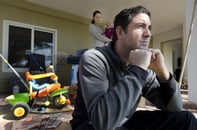Be the Change You Want to See in the University

The following interview is with Jim Robinson, executive director of the Center for Excellence in Public Leadership at George Washington University. At the recent UPCEA Mid-Atlantic Conference, Robinson gave a presentation on higher education leadership through this disruptive period in higher education In this interview, Robison delves deeper into that topic and shares his thoughts on the various challenges postsecondary leaders are navigating in the modern era, what kinds of strategies they need to put into place to succeed and how continuing education divisions should take a leading role in their institution’s innovation process.
Click here to read key takeaways
1. What are some of the biggest disruptions impacting continuing education today?
It was very interesting; I was attending another conference and one of the presenters made a statement that if he took Laura Ingalls from the Little House on the Prairie series and brought her back to today’s environment that she would be pretty much lost except for one place: and that’s in the classroom.
I think that spoke volumes about some of the major challenges. For continuing education, I think a number of our tenets have been really brought into question. Number one, I think we do have to look at the MOOCs; the massive online courses that are being offered for free or sometimes at significantly reduced costs. It’s now possible for persons to string together learning experiences from some of the top universities in the world for free. And, this is at a time when another disruption is in our economy, which is where there appears to be a widening disconnect between education — at least at the undergraduate level — and job prospects.
These two things are coming together and really challenging how people learn and what they pay for their education. To a certain extent, universities have been promoting themselves as gateways to good jobs. The purpose of being educated, the purpose of broadening oneself, the purpose of deepening ones understanding of the world, those purposes have really been minimized and we really emphasize the vocational, job-preparation aspect of higher education.
A major threat is that now we have students who graduate with massive amounts of debt, especially adult learners who participate in continuing education and professional education. They already are burdened with family responsibilities and yet we ask them sometimes to take on additional debt for obtaining various certifications or various graduate degrees through our colleges of professional studies.
So, there’s a disconnect between the ability to pay, the perceived value of the education in the job marketplace and the value of what is being obtained in terms of career access. So, I think these are fundamental challenges from the economics of higher education.
2. Would you characterize these disruptions as positive or negative?
I think that they can be what we make them to be. I think they’re disruptive and they are initially, for us, being experienced as negative. However, within that negative there are tremendous opportunities for innovation if we choose to go that route.
For example, in terms of online education and the cost of education, I think that we have a tremendous opportunity to learn[not only] how to use technology, but to engage learners. I think we have to do a much better job with online education, to use gaming technologies. We have a chance to really break through with how we use technologies, but also I think we have a chance to break through in terms of what we’re learning about the brain’s functioning, about cognition and about neurobiology and really how people learn …
I think another danger of disruption we can look at is from the automobile industry … I go back to the 1970s and I look at the little cars that Toyota was introducing into the American marketplace. The American car companies, General Motors, et cetera said, “Oh, these aren’t really cars, they’re just little toys and we don’t have to worry about them.”
They ceded that lower end of the marketplace to Toyota and other Japanese automakers at the time. I think that to some extent we’re doing that with some of the for-profit universities and their much cheaper model. Currently many of them are not very good and they really don’t have very good online teaching methods. A number of them are starting to be very good, but I think that if we cede to them and say, “Oh, these are just vocational schools, these are just diploma mills,” I’m concerned that we would be undertaking the same response that the automobile industry made. Of course we know that while Toyota initially sold to younger people — to people just getting out of college or still in college — and those people matured as they made more money, then Toyota introduced larger cars working its way all the way up to the premium Lexus model. So, I don’t want to see us repeat that same failing model in professional education or continuing education.
3. What are the most significant hurdles continuing education leaders must overcome in trying to meet these challenges?
From an educational standpoint when you talk about the changing roles of the professor, it may mean different roles. It may mean that you have your traditional lecturer — your outstanding professor who’s a research scientist who imparts her knowledge — and maybe there are others who are more skilled at learning facilitation and they work closely with that professor. I’m not sure what the role divide is, but I think in really paying attention to the quality of online education and of the online experience requires really changes in our teaching methodology and really more devotion of time.
Right now in many colleges and universities, the model is that undergraduates are exploited and put into large lecture halls and basically their tuition funds help to fund graduate education, which tends to have smaller class sizes and I think that model is just not going to work. It’s not going to be tolerated in the marketplace.
The other thing is the kinds of skills that we are engendering in our students; I would say that most of our teaching is geared to left-brain kind of learning and left-brain functioning which is kind of a linear thought process in a world that’s more predictable, that’s more slowly changing, which has been proven to be effective and kind of follows a scientific revolution. Our model is that an excellent leader is able to predict the future — all of our strategic planning and strategic thinking is about predicting the future — and then you do your strategies to guide the organization through that predicted future or future scenario. I think what is happening now is that what is required is a combination of right-brain thinking as well as left-brain thinking. We cannot really predict the future. How are we able to respond and regroup quickly to what is emerging, so how do we sense what is emerged? That requires the abilities of imagination, the abilities of intuition, the ability to relate to diversity and to appreciate diverse points of view, diverse intellectual approaches, diverse ways of knowing. And, I don’t think we do a good job of that, I think that’s a future requirement.
One of the things that also is emerging as a potential disruptor is that in a number of corporations and major organizations … they’re asking the question, “Who has been successful in our company? And, rather than assume those qualities and characteristics and selection criteria that we’ve been using … let’s go in and find the people who have been highly rated, who have been promoted and let’s find out what the quality characteristics are.”
And what they found was that … success was more closely correlated with the ability to think on one’s feet, the ability to solve problems, the ability to learn quickly, the ability to collaborate with others … They found that those qualities that make for success were not necessarily associated with a higher education …
I think we’re going to be challenged to create a professional kind of a baseline of competencies and capabilities that a professional needs in today’s world. I think that will be a challenge because it’s cross-disciplinary, it requires intense student engagement, different kinds of learning activities that engage different parts of the brain and it requires conscious effort to develop conjoined left and right brain, integrated thinking skills.
4. Is there anything you’d like to add about the disruptions that are having in the higher education space today and what leaders need to do to make sure their institutions stay on top of them?
One of the things we talked about in terms of schools of professional education or continuing education is that because those schools are so sensitive to the marketplace and have to make their way in the marketplace and have to attract students, some of the significant constraints of the larger universities of which they are apart constrain the effectiveness of the schools of continuing and professional education. And so, what happens is that schools of continuing and professional education find themselves as really change agent organizations. Not because they choose to, but because they must impact the larger university if they themselves are to survive.
Change usually comes from the periphery, not from corporate headquarters. It comes from those who are out there in different circumstances, different environments, different populations who are encountering innovative, problem-posing situations and have to innovate. And then those innovations then have the opportunity to come back and to affect the larger institution. I think a big challenge that we have is, “How do we function effectively as a change-agent organization within the very institutions that house us?” Do we consciously take on that challenge not from a reactive standpoint; from realizing that well, it is a challenge, it’s also an opportunity for us to be contributors and the vanguard of where our universities need to go.
– – – –
Key Takeaways
- Disruptions are negative in the short-term as they require sink-or-swim changes, but positive in the long-run as a result of the innovations they inspire.
- It is critical that public higher education institutions do not underestimate the strengths of for-profit entrants to the marketplace if they are to succeed.
- Continuing and professional education divisions must be daring in the changes they make in order to inspire their home institutions to make similar changes that adapt to the new postsecondary marketplace.
Author Perspective: Administrator



